Follow this link to a discussion of Bags and Torbas here on Turkotek.
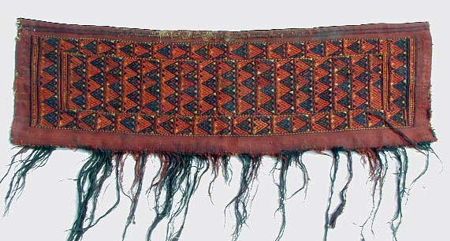
Dave
Flatwoven Bags and Torbas
Greetings
Follow this link to a discussion of Bags and
Torbas here on Turkotek.
Dave
Brocaded Okbash
Greetings Again
Follow this link to a discussion of the Brocaded Okbash here on Turkotek.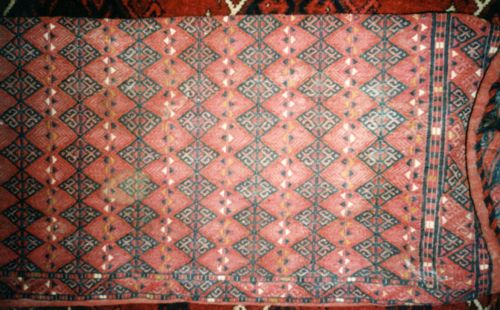
Dave
Hi David,
I am adding pictures of a Turkmen bag I've had for some
time. 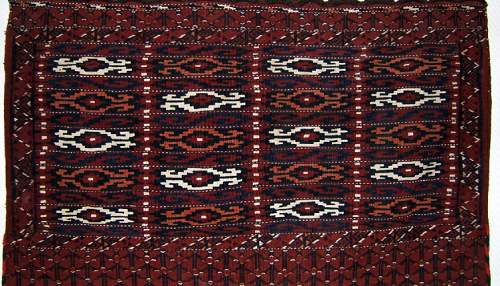
The
bag is in mint condition, probably never used. All colours seem natural to me
and after years of exposure under different conditions on different walls , I
have not yet observed any fading.
It is pobably from the Yomud from Iran. It
has a clear and dark blue and a very dark green that is not much readable from
the pictures.
The border design is taking half of your palas and is worked in
different arrangement horizontally and vertically. The back is also with a
similar design only at the top of the bag.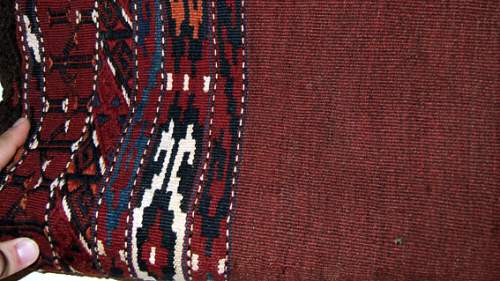
The side finish and the elem
brocading is shown in detail.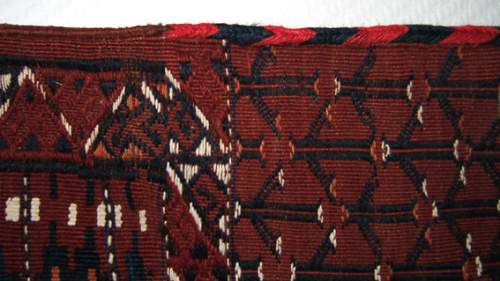
I found a similar example in
the museum in Stuttgart , Germany.
I can not tell the age of the piece
except that it was still made in good tradition and nice materials. We lack of
comparative examples but many I have seen had synthetic dyes.
The design
of the bag seems to have been repeated on a few piled bags also. We find them in
the literature.
In reference to your Salon, I do not yet see any
relationship between the gul designs and the flatweave designs, except for the
work style. This means several symmetries and opposition of diagonal colours ,
arrangement of designs in offset rows etc..
At the current knowledge it would
be a major stretch to generate the known gul designs from these flatweaves.
(Obviously one can generate a lot with mathematical transformations of symmetry
etc. ) but the designs do not seem to be having an ascendant-descendant
relationship.
The flatwoven /embroidered designs of the palas seem to be
more dictated by the weaving techniques, designs refining over years.
On the
other side , given the variety of the Turkment guls and designs we see in piled
media for the last two hundred years seems to indicate that besides the "Turkmen
character" indicated above , the piled media could freely develop and adopt
designs from anywhere.
Regards
Ali
Hi Dave and Ali,
Again.
Why do you think Dave, the Turkman knotted
designs must have had Turkman flatwoven models?
Some think that piled work in
general comes from flatwoven models. Maybe, maybe not.
The older the Turkman
pieces are, the more rounded the designs are. A rounded design needs a technical
freedom in texture and a 1:1 knot density: Thick or more wefts if the warps are
level, or warp depression. So, flatwoven pieces aren't the first examples I
would think of.
Maybe the flattening of the design in Turkman work opend the
door to flatwoven pieces.
Best regards,
Vincent
A little less provocative...
Ali, vincent, All
Maybe I should been less interested in playing
agent provocateur, and gone ahead and made
that key stroke which would
have punctuated the
title with a question mark .
.
The pronouncement in question,
from the Salon, states as follows:
This relationship of design in itself
lends to the proposition that the piled gul weavings proceed from flatwoven.
Consider the following examples of what I believe to be artifacts of the
relationship between flat and pile woven Turkmen designs and their
derivatives.
I confess that it has been some time, and that my
semantic
skills are perhaps not what they once were (if indeed they ever
were )
)
but it appears
that I can/should further discribed
what I believe constitutes this
relationship between
pile and flat weave. Let me start with Ali's
bag.
Nice bag Ali. But please do tell, is this Ikat derived
field
design executed in plain flat weave, or the brocading
utilized in
my palas? Could this be a mixed medium, bracade and flatweave, instread of just
brocade.
Interesting that this Ikat pattern is (I believe) a broadloom
pattern here transcribed into both a brocade/flatweave
pattern, and as I am
sure most of us are familiar,
also found in pile weave medium. As such might
be the
palas and flatweave relationship, for the eminence of
pileweaving
is, it is my understanding, a recent
phenomonon.
Ali states
that:
I do not yet see any relationship between the gul designs and the
flatweave designs, except for the work style. This means several symmetries and
opposition of diagonal colours , arrangement of designs in offset rows
etc..
But this is precisely where I believe the relationship lies. I will
come back with further elaboration soon.
Dave
Hi David,
The bag's field is worked in kilim technique. The borders and
the elems are in a technique I would qualify of "zili".
I will look into some
definitions from books and provide more analysis once I get back
home.
Regards.
Ali
Just another example
Greetings everyone
As stated above.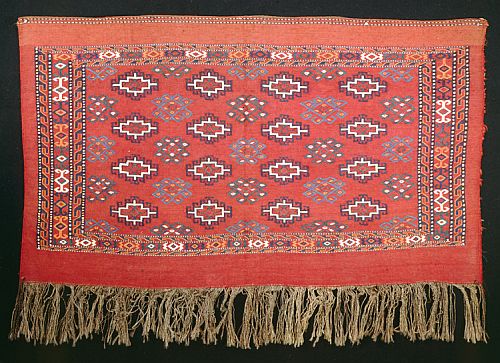
Dave
haç gul
It is very difficult, due to the lack of ancient items, to know, in the case
of Haç gul design, if the prototype is the flatwoven one or the piled. We know
old piled examples (the Crivelli star, for ex) but we don't know very old
flatwoven items (older than mid XIX°). For the Crivelli example we have to note
that the haç gul is used as a single element on the field of the rug and not as
a tesselized motif that covers the all field of the rug, as in Yomud
items.
For the Yomud production, during the same period (mid XIX° to early
XX°) we know several examples of flatwoven chuvals that seem to be archetypal
models (tesselized or stripped haç guls). We know piled bags with the tesselized
haç gul but those bags ar generally small bags or kordjins (more personnal and
more "prestige" items), but never with the chuval format. Yomud use to make
piled chuvals but with another design than haç gul. We don't know piled bags
with stripped design. Piled rugs with the tesselized haç gul motif (see
Bogolyubov example) seem to be "inspired" from the piled bags that could be
inspired from flatwoven chuvals.
This hypothesis is based on the fact that
there is not very old examples of piled rugs with tesselized haç gul known, and
that flatwoven items seem to be older than piled ones (but flatwoven bags wear
faster than piled items due to their fragility and to their harder use).
As
often the lack of old material is always the limit of our
reasoning.
Amicalement
Louis Dubreuil